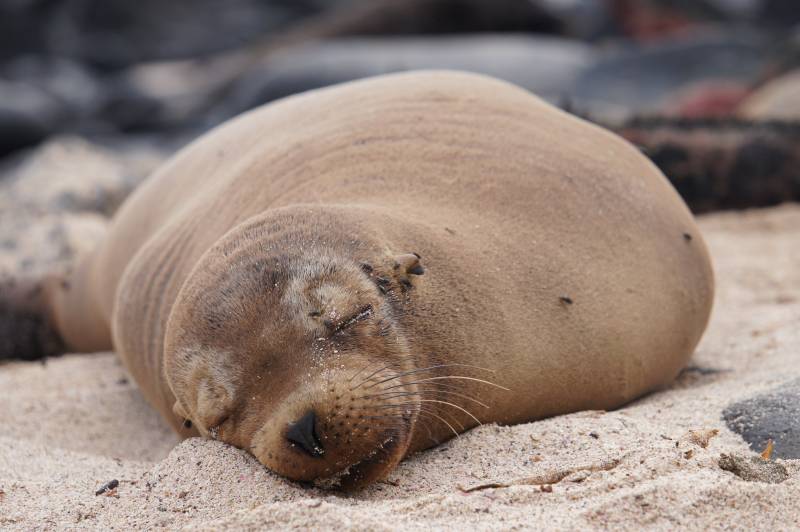
Anthropologists believe that men and women began wearing clothes after the last ice age using animal skins and vegetation. Animals were used for clothing as protection from rain, wind, cold, and heat when migrating to new climates.
Today, many endangered animals are killed for fashion. Billions of animals are brutally slaughtered in the fashion industry each year.
For leather production alone, 2.29 billion of animals had to die in 2018, including cows, calves, goats, pigs, and buffalos.
The wool industry is also responsible for many deaths of sheep, goats, rabbits, and camelids. They live in crowded conditions, are subjected to painful treatments, and exposed to dangerous substances with long-term disastrous effects on ecosystems and human health.
Fur clothes obtained from furry animal hides are viewed as luxurious in fashion today. Animal pelts from foxes, rabbits, and minks are often used to make fur clothing such as coats, jackets, parkas, vests, and boleros.
That's only considering farm animals. Many other exotic and endangered animals are killed for their skin each year.
There is a lot of animal cruelty going on in the textile and apparel industry. Brutal trapping and skinning of endangered animals occur too frequently in the fashion industry.
Why do fashion brands and retailers keep using animals and inhumane practices to make clothing?
I gave up on animal products and by-products in 2015. Now, I choose to use ethical and environmentally friendly alternatives to stay warm and stylish, such as organic cotton, linen, lyocell, or recycled fabrics.
With a bit of research and without breaking the bank, it's now possible to build a noble and responsible wardrobe without using any animals.
Read up my list of the top 10 eco-friendly and sustainable fabrics for clothing to get an overview of many environmentally friendly materials you can choose from.
Contrary to popular belief, wearing clothes made from animal products or by-products is very cruel. They aren't ethical or sustainable materials.
There is no excuse to make animals suffer for clothing today. There are already plenty of other alternatives.
Animals often suffer immense pain, being castrated, dying from exhaustion, exposure to the cold, disease, lack of shelter, or neglect.
There are too many endangered animals used for clothing to list them all. Here are some of them.
Panaprium is independent and reader supported. If you buy something through our link, we may earn a commission. If you can, please support us on a monthly basis. It takes less than a minute to set up, and you will be making a big impact every single month. Thank you!
Alligators and Crocodilians
Crocodilians comprise a vast number of large reptile species, including crocodiles, alligators, caiman, and gharials around the world.
Many of these species are threatened by the leather trade and should be protected.
The American Alligator is an example of endangered animals used for clothing. Populations were severely depleted in the 20th century.
With the help of animal protections such as the Convention on International Trade in Endangered Species of Wild Fauna and Flora (CITES), the American Alligator has recovered.

Australian Kangaroo
The Australian kangaroo industry produces meat and leather products from animals. The kangaroo industry is based on the harvesting of the large species of kangaroos.
The golden-mantled tree kangaroo is one of the very endangered species of kangaroo.
Scientists estimate that the golden-mantled tree kangaroo has been extirpated from 99% of its historical range, due to habitat destruction and hunting.

African Ostriches
Ostrich leather is another animal product of the clothing industry. It's produced by tanning skins taken from African ostriches farmed for their feathers, skin, and meat.
Most ostrich subspecies are not endangered yet. But many of them are hunted regularly and their populations are declining.
According to the International Union for Conservation of Nature's (IUCN) Red List, the Somali Ostrich is now very vulnerable and will become endangered if the hunting and trapping don't stop.

North American Beaver
The North American Beavers were once nearly extinct. Luckily, their population is stable now.
In North America, there were more than 400 million beavers when the first fur traders arrived. By 1900, there were perhaps 100,000.
Trapping animals isn't sustainable. Even though fur made from beaver pelts make great hats, American Beavers should be protected before they become vulnerable again.

Big Wild Cats
There are too many endangered big wild cat subspecies to list them all here.
The Iberian Lynx is the world's most endangered feline species. There are only over 400 of them living in the wild!
The Iberian Lynx is still a victim of poaching, the illegal hunting and capturing of wild animals.

Python leather
Pythons are regularly killed for their skins in Africa, America, and East Asia.
Many species of pythons are on the International Union of Conservation of Nature's Red List of Threatened Species. The Burmese Python is one of them and is categorized as vulnerable.
The Burmese Python is one of the five largest species of snakes in the world. Python invasion has been particularly extensive in South Florida.

Short-tailed Chinchilla
The Short-tailed Chinchilla has the thickest fur of all animals on land. Coats made of chinchilla fur are warm and luxurious. They are regularly hunted for their fur and meat.
They are native to the Andes Mountains located in South America. Today, short-tailed Chinchillas are almost extinct.
Save the Wild Chinchillas is one of the most active non-profit organization working to protect and restore wild Chinchillas.

Seal leather
Seals are still hunted for their skin and meat today. Seal hunting is currently practiced in ten countries around the world.
According to the International Union of Conservation of Nature's Red List, two seal subspecies are already extinct, the Caribbean Monk Seal and the Japanese Sea Lion.
Seven seal subspecies are endangered and four of them are vulnerable. It's now more than ever necessary to protect the seals and making changes. Their numbers are drastically low.

Antelope Species
Out of 91 Antelope species, 25 are threatened with extinction, as reported by the IUCN. Five of them are critically endangered, including the Dama Gazelle and the Saiga Antelope.
Most antelopes are found in developing countries. Most of them are native to Africa. Many species of antelopes have been imported to the United States for exotic game hunting.
Antelope leather is used to make shoes, boots, jackets, coats, and hats.

Bear fur
Many bear species are currently threatened with extinction. Their population is decreasing rapidly.
The U.S. Fish and Wildlife Service listed the grizzly bear as a threatened species under the Endangered Species Act in 1975. Currently, all grizzly bears in the lower-48 states are protected as threatened.
Bears have been hunted since prehistoric times for their meat and fur. Poaching and illegal international trade of threatened bear populations continue to this day.

Was this article helpful to you? Please tell us what you liked or didn't like in the comments below.
About the Author: Alex Assoune
What We're Up Against
Multinational corporations overproducing cheap products in the poorest countries.
Huge factories with sweatshop-like conditions underpaying workers.
Media conglomerates promoting unethical, unsustainable products.
Bad actors encouraging overconsumption through oblivious behavior.
- - - -
Thankfully, we've got our supporters, including you.
Panaprium is funded by readers like you who want to join us in our mission to make the world entirely sustainable.
If you can, please support us on a monthly basis. It takes less than a minute to set up, and you will be making a big impact every single month. Thank you.































0 comments